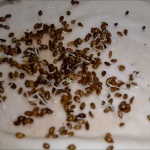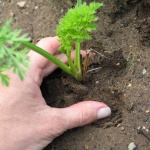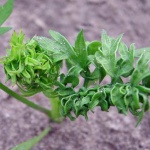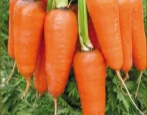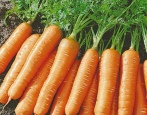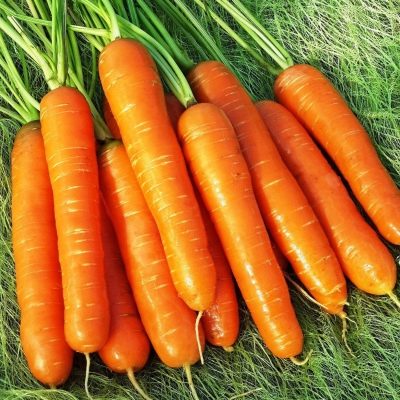
- Year of approval: 1943
- Appointment: for fresh consumption, for canning, for freezing, for bundled products, for making juice
- Leaf rosette shape: semi-standing
- Leaves: medium, green
- Weight, g: 90-160
- The form : cylindrical, blunt tip
- Taste qualities: gorgeous
- Ripening terms: mid-season
- Growing regions: North, North-West, Central, Volgo-Vyatka, TsChO, North Caucasian, Middle Volga, Nizhnevolzhsky, Ural, West Siberian, East Siberian, Far East
- The size : average
Carrots are a favorite vegetable not only for adults, but also for children, so many summer residents grow this crop. The Nantes 4 variety is in special demand due to its excellent taste, unpretentious care and a high percentage of carotene content in root crops.
Breeding history
Carrot Nantes 4 is one of the very first varieties that were obtained on the territory of the USSR. The year of entry into the State Register is 1943.
All work and tests were carried out at the Gribovskaya selection station, starting in 1930. The originator of the carrots was the Moscow agrofirm "Aelita". The authors of the variety are Nasrullaev N.M. and Karakay I.T.
Description of the variety
Each culture has its positive and negative sides. Carrots of Nantes 4 are no exception. The advantages of the culture include high yield and long shelf life. Root crops sprout amicably, and they have practically no voids in the pulp. With proper care, the fruit does not crack. Carrots have excellent taste characteristics. Vegetables can tolerate a slight drop in temperature (down to -4 ° C).
Among the disadvantages can be noted the exactingness of the soil and the need for regular watering.
Characteristics of the appearance of the plant and root crops
The rosette is semi-spreading, high. Carrots have strong tops. The leaves are medium, dissected, have a rich green tint.
Root crops are medium in size, cylindrical in shape. The tip is round and blunt. Weight - 90-160 g. Length of carrots - 15-17 cm, diameter is 4-5 cm. The color of the bark is rich orange. At the stage of technical maturity, the fruits may protrude slightly from the soil, so green or purple pigments appear on the base. The surface is smooth.
The core is small, rounded, without obvious voids. The color is identical to the color of the root crop itself. The pulp is juicy, tender, dense and crunchy.
Purpose and taste of tubers
Carrots of Nantes 4 can be eaten fresh, made salads or added to hot dishes and soups. It is also suitable for making juices and mashed potatoes and preserves. The taste of the fruit is bright, sweet, without bitterness.
Root vegetables are rich in beta-carotene - 19.5 mg. Fructose - 9.1 mg per 100 g. The energy value of 1 fruit is 25.5-30 kcal. Vegetables also contain essential trace elements and vitamins.
Maturation
The variety is classified as a mid-season crop. From the moment of germination to harvest, approximately 78-108 days pass.
Yield
Carrots of Nantes 4 have a high yield. From 1 m2 you can collect 4.2-6.5 kg, and from 1 hectare - 25-65 tons.
Growing regions
Since the variety was one of the first to appear, its focus was on almost all regions. Therefore, the culture is adapted to different regions and climatic conditions. The best yield indicators were recorded in the Central Black Earth Region, North-West, Central, Nizhnevolzhsky, Volgo-Vyatka, East Siberian regions.
Growing and care
When buying seeds, it is important to pay attention to the year of production, because the percentage of inputs depends on this.Many gardeners claim that if the seeds are 1 year old, then the harvest will rise by 85-95%, and if the material is already 2 years old or more, then the percentage of seedlings can be 30-50.
And also future germination can be determined by the smell of seeds. Each seed contains a high concentrate of essential oils, and the fresher the batch, the more intense the aroma.
Variety Nantes 4 is ideal for multiple planting. The first can be done in March, and the second in mid-July.
Before planting, purchased seed pellets can be soaked in a growth stimulant solution. But self-collected material should first be treated with a solution of potassium permanganate. After processing, the seeds should not be rinsed with water.
Some summer residents pre-germinate the material, and someone immediately sows in the garden. Everyone chooses the best option for themselves, based on the weather conditions and the growing region.
The place for growing is chosen sunny, since the sugar content in the fruits directly depends on this. The soil should warm up to 8-10 ° C. The distance between the rows should be 15 cm.The seeding pattern is as follows: 20x5 cm or 30x8 cm.
Agrotechnical care should include the correct irrigation regime. Before sprouting, the garden bed is watered every morning. After the tops grow to 15 cm, the watering regime is reduced to 3 days. Adult root crops are watered once a week, but very abundantly.
Thinning must be carried out several times per season. If there is a strong thickening, then the carrots will be small and not very tasty. First, the distance between the roots is increased to 4 cm, and then to 8 cm.
Weeding and loosening of the soil is carried out after each watering.
The first top dressing should be applied within 14 days after the appearance of the first shoots. For this, a special solution is prepared from urea and superphosphate.
The second time, top dressing is applied after 3 weeks. For the procedure, take a solution of potassium sulfate and superphosphate. Carrots can be fed with wood ash, boron and potassium permanganate. From organic matter, this can be fresh manure or chicken droppings.
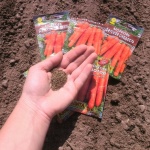
Carrots are one of the most unpretentious crops in terms of growing conditions; they can endure a short drought and a short cold snap. However, to get tasty and large root crops, you should adhere to the basic rules for planting carrots.


Soil requirements
Carrot Nantes 4 grows well on sandy loam, loamy or peat soils. And also when digging, you can add humus, cow dung and sand.
Disease and pest resistance
In the absence of care and non-compliance with simple aspects of agricultural technology, root crops can become infected with phomosis. It appears as brown spots on the skin. When it appears, the soil should be treated with an aqueous solution of the "Maxim" preparation.
Also, tops and root crops can become infected with brown spot. It covers the carrots with rusty spots, the tops darken and wither, and the fruits begin to rot. A solution of the fungicide "Gamair" is suitable for processing infected vegetables.
To fight slugs, you can use Thunderstorm, as well as thick eggshells.

Carrots grow in almost any garden. There is an opinion that this culture is very resistant to all kinds of diseases and pests, but this is not the case.Without proper care, carrots become susceptible to all kinds of infections and are affected by harmful insects.


